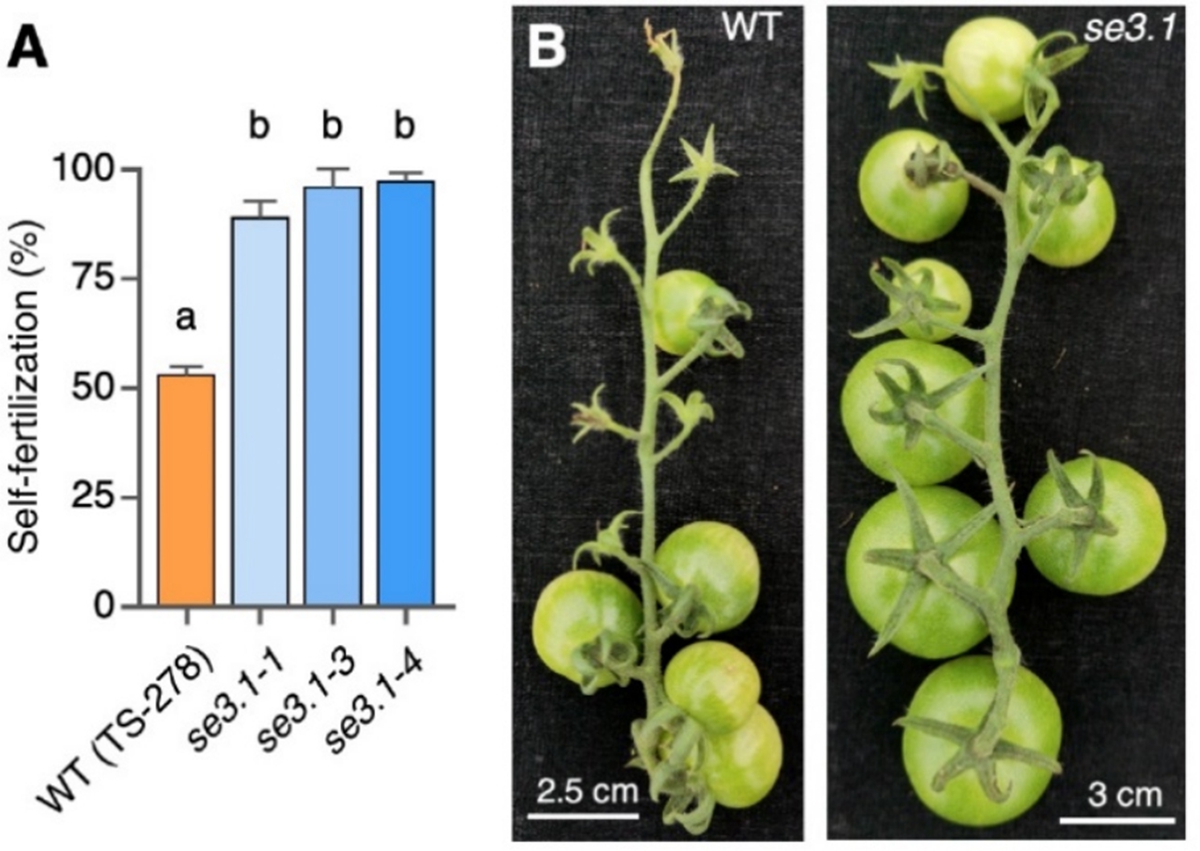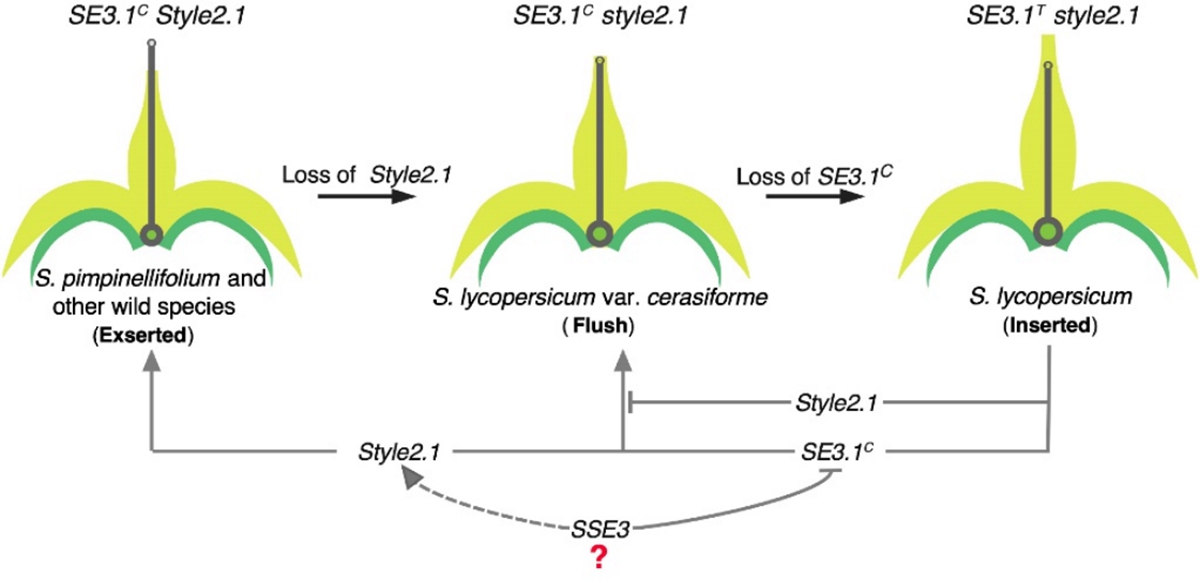南湖新闻网讯(通讯员 尚乐乐)近日,我校叶志彪教授领衔的番茄团队鉴定了一个新的控制番茄柱头延伸程度的基因,即Stigma Exsertion 3.1(SE3.1),进一步揭示了番茄驯化和改良中自花授粉的转变过程,相关研究成果以“A mutation in a C2H2-type zinc finger transcription factor contributed to the transition towards self-pollination in cultivated tomato”在The Plant Cell发表。
植物进化与其授粉方式密切相关。从异花授粉到自花授粉转变是植物中最常见进化方式之一,大约10%到15%的开花植物依赖于自花授粉。许多作物都经历了由异花授粉向自花授粉的转变,在异花授粉向自花授粉的转变过程中,除了自交不亲和性的丧失,花的形态改变尤为重要,例如柱头由外露向内缩转变,以适应自花授粉。然而,这一转变潜在的分子机制仍然未知。
在本研究中,我校番茄团队利用277份包含野生和驯化改良番茄材料的多样性群体,对花药长度和雌蕊长度进行量化,确定柱头延伸程度的数量变异特征。与野生材料相比,樱桃番茄和大果番茄的柱头延伸程度降低,表明番茄驯化和改良伴随柱头延伸程度的显著降低。
通过全基因组关联分析,该研究鉴定到一个与柱头延伸程度显著相关的位点。团队通过群体变异分析和基因重新注释获得了一个编码C2H2类型的转录因子的基因SE3.1。SE3.1编码区域一个SNP的差异形成两种等位基因型 (SE3.1C 和 SE3.1T)。在番茄群体中,SE3.1C突变为SE3.1T会导致翻译提前终止,不能形成功能蛋白,进而导致栽培番茄中柱头内缩于花药筒内部。功能互补实验证明了SE3.1控制柱头平齐于花药筒顶部与内缩于花药筒内部之间的转变过程,并且柱头延伸程度是在花发育的较早时期决定的。此外,在柱头平齐于花药筒顶部的材料中突变出SE3.1后,柱头内缩于花药筒内部,这一转变过程促进了自交率的显著提高。

SE3.1调控番茄柱头延伸和自交率
在番茄驯化和改良过程中,SE3.1受到选择。Style2.1是控制番茄柱头外露的另一个主效位点。本研究对番茄资源材料中SE3.1和Style2.1进行基因分型,发现外露材料(野生番茄)同时具有SE3.1C和Style2.1基因,柱头平齐材料(樱桃番茄)仅发生Style2.1突变,而柱头内缩材料(栽培番茄)发生SE3.1T和Style2.1双突变。在柱头外露材料TS-19中敲除Style2.1获得平齐柱头,同时敲除SE3.1和Style2.1获得内缩柱头。综上,番茄柱头由外露到内缩的转变分别是由Style2.1和SE3.1分两步调控实现的,第一步是由Style2.1的突变导致柱头由外露到平齐于花药筒顶部,第二步是由SE3.1突变完成柱头由平齐于花药筒顶部到内缩于花药筒内部的转变。该研究为探究番茄柱头延伸程度演化提供了良好框架,为现代栽培番茄选择育种柱头内缩材料提供了理论依据。

番茄柱头外露到内缩是由Style2.1和SE3.1依次分两步演变
我校番茄团队博士研究生尚乐乐、博士后宋建文为论文共同第一作者,张余洋教授为论文通讯作者。课题研究依托我校园艺植物生物学教育部重点实验室和湖北洪山实验室完成。该研究获国家自然科学基金、国家重点研发计划等项目的资助。
审核人:叶志彪
【英文摘要】
The degree of stigma exsertion has a major influence on self-pollination efficiency in tomato, and its improvement is essential for raising productivity and for fixing advantageous traits in cultivated tomato. To study the evolution of stigma exsertion degree in tomato, we searched for genes associated with this trait and other aspects of flower morphology, including the lengths of anthers, styles, and ovaries. We performed a genome-wide association on 277 tomato accessions and discovered a novel stigma exsertion gene (SE3.1). We reannotated the structure of the gene, which encodes a C2H2-type zinc finger transcription factor. A mutation of the lead SNP creates a premature termination codon in SE3.1 and an inserted stigma in cultivated tomatoes. SE3.1 is essential for the conversion of flush stigmas to inserted stigmas. This conversion has a major impact on the rate of self-fertilization. Intriguingly, we found that both SE3.1 and Style2.1 contribute to the transition from stigma exsertion to insertion during the domestication and improvement of tomato. Style2.1 controls the first step of exserted stigmas to flush stigmas, and SE3.1 controls the second step of flush stigmas to inserted stigmas. We provide molecular details for the two-step process that controls the transition from stigma exsertion to insertion, which is of great agronomic importance in tomato.
